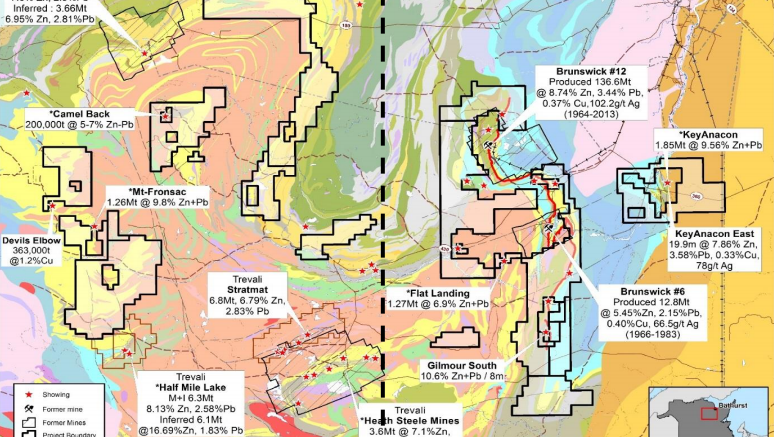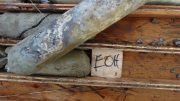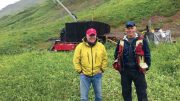In the last year, newly minted Osisko Metals (TSXV: OM; US-OTC: BWMXF) has picked up over 500 sq. km in New Brunswick’s Bathurst mining camp, the third-largest volcanogenic massive sulphide (VMS) camp in the world.
“We’ve been scouring the base metal space looking for new opportunities,” Jeff Hussey, the junior’s president and CEO, told analysts and investors during a presentation at Red Cloud’s annual fall conference. “We are also trying to define a cluster of deposits in the Bathurst mining camp within a 25 to 30 km trucking distance that would feed a central concentrator.”
The company’s focus is on zinc due to the current market fundamentals, a base metal whose price has doubled to US$1.43 per lb. over the last 12 months, and one which Hussey knows well after spending 20 years at Noranda, including a stint working at the Brunswick No. 12 mine in the Bathurst camp.
Brunswick No. 12 was the world’s largest underground zinc mine and produced 137 million tonnes of ore grading 8.74% zinc, 3.44% lead, 0.37% copper and 102 grams silver per tonne over its 49-year lifespan. The Brunswick No. 6 mine, a pit just south of Brunswick No. 12, developed 13 million tonnes at similar grades.
Osisko Metals’ 129 sq. km Brunswick Belt project, 25 km southwest of the city of Bathurst, covers parts of the strike length that hosted both the Brunswick No. 12 and No. 6 mines to the east, and the company says the area warrants exploration for smaller-scale, stand-alone operations within the brownfield Brunswick horizon geology. (Previous exploration work has been undertaken by Brunswick Mining and Smelting, Noranda, Xstrata, Glencore [LON: GLEN], and most recently, Votorantim.)
The Brunswick No. 12 mine shut down in 2013, and with the more recent closures of the Century zinc mine last year and the Lisheen zinc mine in 2015, Hussey says, the metal’s prospects look bright.
“Supply has basically been destroyed over the last four or five years and we’ve seen the corresponding increase in the zinc price,” he says. “Because of the neglect in the zinc space, the pipeline is relatively barren, and it’s much harder to find zinc projects than it is to find copper projects, globally.”
On the demand side, more and more of the large infrastructure projects globally require zinc to galvanize steel, he says, pointing to Montreal as an example of a city whose aging infrastructure needs to be built anew.
“We’re living in Montreal and all of the infrastructure, all of the highways, were built in 1967, and they’re all falling apart at the same time,” Hussey says. “We’re redoing all of our highways right now, and most of the new highway infrastructure uses galvanized steel because they want it to last longer and be more sustainable.”

A drill rig on Osisko Metals’ property in the Bathurst mining camp. Credit: Osisko Metals.
Osisko Metals’ first step is to build a resource base from historic deposits and in September kicked off a 50,000-metre diamond drill program focused on definition and expansion drilling at its wholly owned Gilmour South, Mount Fronsac, Flat Landing Brook and Louvicourt deposits.
In November, the company reported its first drill intercept from Gilmour South, 35 km southwest of Bathurst, 20 km southeast of the Brunswick No. 12 mine and 7 km south of the Brunswick No. 6 mine. The 7.6-metre intersection graded 11.31% zinc, 2.10% lead, 0.16% copper, 20.95 grams silver per tonne and 0.21 gram gold, from 592 metres downhole.
At Mount Fronsac, a relatively large sulphide deposit that hosts high-grade mineralization locally, drilling got underway in November. Noranda found the deposit in 1999 by prospecting near a soil geochemical high, which Osisko Metals says showed that not all the potential in the camp is at depth.
Osisko Metals acquired Mount Fronsac in July, and the deposit has a historic resource of 1.26 million tonnes grading 7.65% zinc, 2.18% lead, 0.14% copper, 40.3 grams silver and 0.40 gram gold.
At the end of November, Osisko signed an agreement to acquire four claim groups in the Mount Fronsac North area, three of which are believed to host the northern extension and downdip potential of the company’s Mount Fronsac North deposit. (The fourth claim group is a separate block 5 km east of the Mount Fronsac North deposit that covers similar stratigraphy.)
Osisko Metals’ Flat Landing Brook VMS deposit is also hosted in the Brunswick horizon, west of the former Brunswick No. 6 mine. Concentrated zinc-lead-silver mineralization occurs in four mineralized horizons hosted within the Brunswick horizon, and a historical resource dating from the late 1970s that estimates 1.27 million tonnes of 5.62% zinc, 1.29% lead and 23 grams silver.

“Because of the neglect in the zinc space, the pipeline is relatively barren, and it’s much harder to find zinc projects than it is to find copper projects, globally.”
Jeff Hussey
President and CEO, Osisko Metals
To the west of Flat Landing Brook is the company’s smallest deposit, Louvicourt, which has a historic resource of 136,000 tonnes grading 1% zinc, 1.23% lead, 90.86 grams silver and 0.96 gram gold. Louvicourt, also known as the Nine Mile Brook deposit, has two conformable massive sulphide lenses associated with a barite-rich iron formation.
The company plans to take magnetic and gravity data from publicly available surveys to carry out 3-D inversions and reconcile them with its interpretation of the geology to improve drill targeting.
The idea, Hussey says, is to go back into these small, 1.3-million or 1.5-million-tonne deposits, and try to grow them to 3 to 4 million tonnes.
“If we get three of those within a 25 km trucking distance, we’ll have sufficient feed to go into a developmental story and do an economic study,” he says. “Our objective is a minimum threshold of 10 million tonnes at 10% lead, plus zinc combined. We’ll be trying to do that in the east side of the camp and the west side of the camp.”
Osisko Metals’ holdings also benefit from their location 67 km by rail from the port of Belledune, a deepwater facility that can service capesize vessels (100,000 DWT), with year-round cargo handling.
“Everything is there — we’re very close to tidewater — so the world markets are within a short distance of the camp,” Hussey says. “We just have to get it on the ship, and away we go.”
Hussey notes that the company has raised $41.5 million and has technical backing from the Osisko Group, who built the Canadian Malartic mine. Two of the founders of the original Osisko, Robert (Bob) Wares and John Burzynski, sit on the junior’s board of directors. In addition to Wares and Burzynski, serial mine builder Luc Lessard also sits as a director of the company.
“I don’t think you can find a better board in the base metal sector in our junior mining peer group,” Hussey says. “John has great access to capital, he’s known worldwide for all of the work that has gone on in the Osisko Group, and Bob and I have known each other for over 20 years and worked together in Quebec. We’ve always worked in parallel and now we’re working together, and that’s great. Luc Lessard built the Canadian Malartic mine and has 11 mines built under his belt, and he’s working on his twelfth.”
In addition to its properties in New Brunswick, Osisko Metals is also looking for zinc in Quebec, where it has accumulated a package of projects it calls “Quebec Genex,” among them Schefferville, the largest continuous zinc lake sediment anomaly in Eastern Canada. The source of the zinc anomalies has never been found, but could be one or more blind sequential extraction deposits.
“We are also looking to acquire stranded base metal assets in Canada as a next step. We’re well managed, we’re well funded and we have what we think is the best zinc growth story in the space.”
The company’s largest shareholders are Osisko Gold Royalties (TSX: OR; NYSE: OR) and Osisko Mining (TSX: OSK; US-OTC: OBNNF), with 20.2%; Blackrock, M&G, JP Morgan and CDPQ, with 41.1%; and management and insiders, which hold 12.2%.
“Seventy percent of the stock is held in long-term hands, and we know roughly half of the shareholders holding the remaining 30% of the stock, so it’s a very tightly held stock,” Hussey says.
The company’s shares are trading at 90¢ within a 52-week range of 21¢ (December 2016) to $1.74 (August 2017).






Be the first to comment on "Osisko Metals consolidates Bathurst camp"